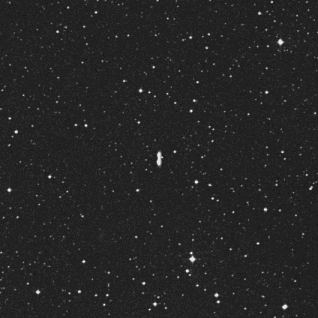
Obscure Planetaries of the Summer
July, 1999's Observational Astronomy class gave me a chance to hunt down some obscure planetaries when the students pooped out around midnight. In addition, Jay McNeil's article (Summertime Planetaries Beyond the NGC) in the August, '99 issue (p.122) of Sky and Telescope added six more challenging planetaries to my list. I will start with Jay's list:
All observations made with my 17.5 f/4.5 equatorially driven reflector under mag 6.5 skies. Altitude: 7200 feet. Seeing and transparency (over several nights) varied from good to exceptional; refer to specific notes (below) for other conditions, good or bad. I usually had several observers to share--and confirm--my impressions at the eyepiece with: Steve Gottlieb, Jim Shields, Kevin Daly, and Ira Stein.
All images from the online DSS site; fields are 15' square (unless otherwise noted); North is at the top, West is to the right.
Minkowski 2-9
| 17 05 37.7; -10 08 33 | Oph |
Urano: 292 |
Mag:13.2 |
Size: 60"x30" |
| A curious "proto-planetary" which did not respond to either my Ultrablock or OIII filters. Still, quite bright at 13.2 mag., and no problem to spot in the 9-Nagler 22' field at 222x. My first impression was that it looked like a spiral--almost edge-on galaxy, yet it had a curiously bright center, which turned out to be stellar at times of good seeing. I could not detach the star from the "wings" of Minkowski's butterfly (even at 417x with my 4.8 Nagler), as Jay did in his drawing, or as the glorious Hubble image does, in all its color. Still, there is something that distinguishes this image from your everyday run-of-the-mill elongated galaxy (which it is NOT, of course) at the eyepiece: Besides the stellar center, perhaps the sudden, visible attenuation of the wings? |
|
Henize 1-6
| 20 17 21.5; +25 21 44 | Vul | Urano: 163 | Mag. 14.9 | Size: 18.8" |
|
Very faint. Best view with 7 Nagler (286x) and OIII filter. Very slightly elongated N/W to S/E. Definitely non-stellar; but no color, annularity, or other exciting features glimpsed. |
Abell 70
| 20 31 33.6; -07 05 19 | Aql | Urano: 298 | Mag: 14.3 | Size: 42" |
| Another very curious planetary, not the least of it due to a galaxy
shining through its northern edge (top in image to the right). Probably the toughest to find of Jay's list, due to an amalgam of stars in finder and eyepiece which would not lend themselves to easy asterisms; at least to my mind's eye! Neither my OIII or Ultrablock filters helped with this one. 4.8 Nagler (417x) used to bring out detail: Annularity glimpsed only with averted vision (otherwise a circular "blur"); northern edge only slightly brighter. No sign of central star. A very rewarding and challenging object. |
|
Humason 1-2
| 21 33 08.1; +39 38 04 | Cyg | Urano: 86 | Mag: 12.7 | Size: 8.3" |
|
I had high hopes for this one: Jay's drawing depicts a dumbbell shape, not
unlike a micro M27. Unfortunately, I gave up on this one the first night out because I
could not ID any starfields! Turns out I was pointed between two "other"
stars nearby... The next night, I found this planetary quite rapidly. No hourglass shape detected. Two "globule-like" poles detected--N/W to S/E. Very irregular dispersion of light. As usual, used 9, 7, and 4.8 Naglers. I have no notes concerning filters, though I am sure I experimented with them! OOPS! |
IC 5217
| 22 23 55.8; +50 58 00 | Lac | Urano: 57 | Mag. 12.6 | Size: 6.6" |
| With 4.8 Nagler: Bright, bluish, a "blurred" star (yes, that's it in the center of the picture at the right). Not too exciting. However: a beautiful string of stars in the northwest 9 Nagler field of view (22'); approximately 8' from the planetary. |
|
Merrill 2-2
| 22 31 43.8; +47 48 04 | Lac | Urano: 87 | Mag: 11.5 | Size: <5" |
|
At less than 5", the smallest, brightest (and last) of McNeil's list. That's it, the center "star"in the Aries-like asterism to the left. I could not make out any tell-tale planetary features; though, at 11.5 Mag, it was bright. Of all the planetaries on Jay's list, this one responded to an OIII filter the best. Unmistakably a planetary when "blinking" with an OIII. I did not find the field as hard to find as the myriad of stars in this portion of the Milky Way might seem to make it. |
A couple other challenging planetaries:
Abell 74
| 21 16 51.6; +24 09 49 | Vul | Urano: 165 | Mag: 12.2 | Size: 13.8' |
| I returned to this one after fist hunting it down (with much difficulty)
last summer. This image, like all my others are from the DSS Palomar Site. If you can't
see the hourglass shape with your browser, I suggest you download the image directly from
DSS like I did. This is a 30' square image, BTW. The "hourglass" is huge (at
least 13.8'), fully 1/3 of the image at right. That's a galaxy (MCG +4-50-4) the brightest
blur in the photo, shining through the planetary. My notes from 1998: With much concentration, I finally began to see a very large, very, very faint oblong(?) disk. I called my friend Ira Stein over (who was viewing with his C-8) for confirmation. He said (again, after much concentration) that he detected a faint "figure eight" pattern. I could see what he was talking about... but all this was on the verge of "averted imagination," if you know what I mean. The next day, I began looking for it on RealSky with Steve Gottlieb. Nothing, at first... until we started manipulating the image. Below, I try to reproduce what came out (this time using the higher resolution DSS images, which I downloaded from the StSci site. (images are below with my '98 notes). My 1999 notes: Saw galaxy with 9 Nagler (222x). Planetary tougher than last year... Not as near the meridian (20-degrees from culmination?), for one thing. No hint of "hourglass" shape this time, but rather a very soft, amorphous glow... thought I saw some brightening at the southwestern portion. Using OIII with 19 Panoptic (105x), of course. I called Ira and Steve over to confirm. Ira could not detect anything this year. Steve had great difficulty but could make out the same amorphous glow I detected. |
|
Wein 1-10
| 20 31 52.6; +48 52 41 | Cyg | Urano: 85 | Mag: 15.1 | Size: 3.2' |
|
This one skunked me last year. I came armed with better finder
charts this year and quickly tracked down the field. Can you see the tenuous annular glow
in the center of the picture at left? I fear it will be erased when I upload this
image to my server. Again; download your own image from the DSS site, if you like. My notes: Barely detectable faint glow with averted vision, OIII and 19 Panoptic. |
Notes from 1998...
A Few Large Planetaries of Summer
I generated the following list using MegaStar: I set the parameters to filter out all DSO's except planetaries two minutes in size and larger between RA 16 and 24 hours, and the DEC for above -30 degrees. I set the magnitude limit at 16.
The emphasis here is few... unfortunately, I struck out more often than not. All images come from RealSky, usually after fiddling with the "background and range" controls. I was using my 17.5 f/4.5 coupled with a 26mm Plossl, and either an Ultrablock or OIII filter.
| Abell 39 13.7 mag 2.9' in
size. 16 27 33.4; +24 54 35 Ura 156 Hercules Jim Shields told me about this one. Finding it for myself (an easy star-hop in Hercules, BTW), I found it quite faint with an Ultrablock filter. Borrowing Steve's OIII, it was a little more evident. A large, round, featureless glow. |
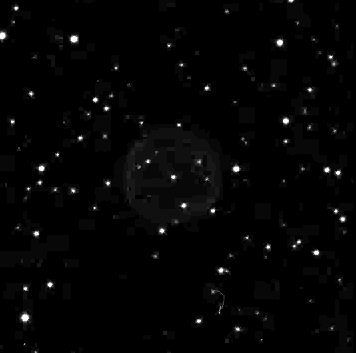 |
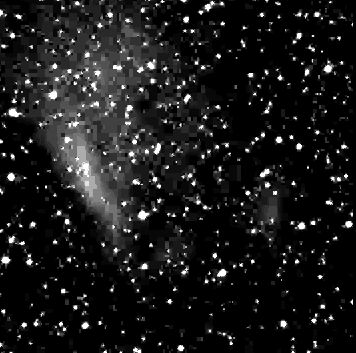 |
Not a planetary, BTW, but it did pop up on Megastar, and it was interesting: SH2-68
10.0 mag 6.7' in size. 18 25; +00 51 38 Ura 250
Serpens
|
Abell 56 15.5 p.mag 3.3' in size. 19 13 07; +02 52
48 Ura 251 Aquila
Looked for, did not see.
Abell 61 14.4 p.mag 3.2' in size. 19 19 9.8;
+46 14 36 Ura 83 Cygnus
Skunked, again.
Abell 62 14.8 p.mag 2.6' in size. 19 33 19.6;
+10 36 58 Ura 207 Aquila
Strike three! (good thing I make my own rules!)
| Abell 65 15.2 p.mag 2.3' in size. 19 46
35.2; -23 08 21 Ura 342 Sagittarius Wedge shaped? Pretty bright. Photo shows oval. |
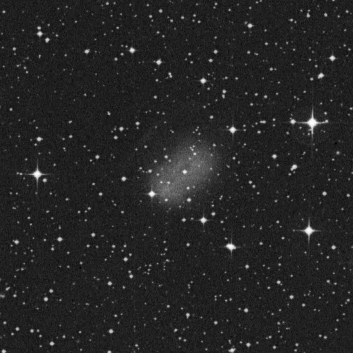 |
Abell 66 14.9 p.mag 4.5' in size. 19 57 31.8;
-21 36 37 Ura 342 Sagittarius
Skunked!
M27 7.6p.mag 6.7' in size.
Y'all know this one. I did not even look at it--though it was on my list.
Wein 1-10 15.1 p.mag 3.2' in size. 20 31
52.6; +48 52 41 Ura 85 Cygnus
I looked in this area a LONG time. I did not see anything which resembled a
planetary. I did see a beautiful area interlaced with dark nebulae and emission nebulae?
Nothing was plotted on Uranometria; still, an area worth checking out
again.
Abell 71 15.2 p.mag 2.6' 20 32 24.6; +47 20 59
Ura 85 Cygnus
This one is plotted on Uranometria, but I could not see it!
Abell 72 14.6 p.mag 2' in size. 20 50 1.9; +13 33 30
Ura 209 Delphinus
Again: plotted on Uranometria, but I could not see it.
Abell 74 12.2p.mag 13.8' in size! 21 16 52.3; +24 08
52 Ura 165 Vulpecula
With much concentration, I finally began to see a very large, very, very faint
oblong(?) disk. I called my friend Ira Stein over (who was viewing with his C-8) for
confirmation. He said (again, after much concentration) that he detected a faint
"figure eight" pattern. I could see what he was talking about... but all this
was on the verge of "averted imagination," if you know what I mean. The next
day, I began looking for it on RealSky with Steve Gottlieb. Nothing, at first...
until we started manipulating the image. Below, I try to reproduce what came out (this
time using the higher resolution DSS images, which I downloaded from the StSci site. For comparison, I
include the Helix Nebula (NGC 7293) at the same scale, purportedly the largest planetary
in the sky:
The Helix: 7.5 p.mag 16.3' in diameter
|
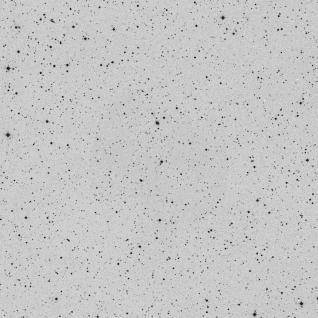 Abell 74 (negative
image) 12.2 p.mag;
|
| Jones 1 15.1 p.mag 5.3' in size.
23 35 53.5; +30 28 02 Ura 124 Pegasus A real favorite of mine; ever since Steve showed this to me a few years ago. In fact, I was probably hunting for other planetaries like this one when I made this list. An easy star hop in Pegasus, the upside down flying horse. Faint; but a large annular structure, with the two opposite lobes distinctly brighter. |
|
Also on my list, but which I did not get a chance to look for yet:
Abell 79 15.8 p.mag 2' in size. 22 26 16.3; +54 49 38 Ura 57 Lacerta
Abell 84 14.4 p.mag 2.5' in size. 23 47 43.5; +51 24 02 Ura 35 Cassiopiea
Ngc 7293, The Helix Seen many times before; but, like M27, I just wasn't interested in the bright stuff...
back to:
HOME